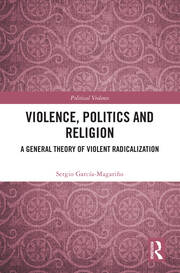Description
This book offers a general theory of violent radicalization and uses case studies from a variety of different countries and groups to illustrate this.
The first and fundamental objective of the book is to provide an explanatory framework to understand phenomena related to violent radicalization, deradicalization, the prevention of radicalization and to political violence; in particular, that inspired by religion. The second objective follows from the first. Understanding violent radicalization of religious inspiration implies delving into two key concepts: violent radicalization and religion. This second objective is indeed elusive, since, on the one hand, many liberal democracies have undergone processes of secularization or, at least, have lost interest in examining religion in public debates. Therefore, rigorously exploring social problems where religion seems to be involved, in one way or another, is complicated. Moreover, the notion of violent radicalization, in turn, is highly contested and confused with other ideas, such as polarization, extremism, terrorism or nonviolent radicalization. Finally, the book aims to bring theory into dialogue with empirical phenomena, and to test it against concrete cases related to violent radicalization and its prevention, on the one hand, and religion, on the other. The book’s originality comes from both its innovative, methodological approach and its breadth, with cases from several countries (Spain, the United States, Ireland, India, Israel, Russia and Colombia) and different ideological groups (revolutionary communists, nationalist movements, Jihadist groups, white and black supremacists).
This book will be of much interest to students of terrorism and political violence, radicalization, sociology and international relations in general.
Table of Contents
Introduction
Part One. Theoretical And Methodological Foundations
1. The Importance and Challenges of Studying Religion in Modern Society
2. Factors Related to Violent Radicalization: The Macro, the Meso and the Micro
3. Towards An Empirically Based Theory on The Nature of Violent Radicalization: Moral Structure, Community and Jihadism
Part Two. Case Studies
4. Comparative Analysis of Different Types of Violent Radicalization: From ETA, the IRA and the FARC, to the American Extreme Right
5. The Pseudo-Religious Narrative of Silicon Valley
Part Three. Prevention and Deradicalization
6. The Role of Individual and Territorial Indicators: The Strange Connection Between the Socioeconomic Structure of Neighborhoods and Terrorism
7. Prevention Programs and Deradicalization: The Shift Towards Resilience
8. Theory in Action: Programs Around the Notions of ‘Moral Structure’ and ‘Community’
Epilogue And Conclusions
Critics’ Reviews
‘Sergio García Magariño’s new book is big, important, and original. It is big because (though it centers on Spain), it draws on cases of religious-inspired violent radicalization from across the world. It is important because —unlike many western studies of jihadist movements— it takes the religious basis of the phenomenon seriously. And it is original because —again, unlike many reductive studies— the author combines micro, meso, and macro level factors that contribute to the phenomenon in question. This is a ‘must-read’, both for those who are concerned about violent radicalization in Spain and readers with a more theoretical interest in the phenomenon of religious-based violent radicalization.’
Sidney Tarrow, Cornell University, USA
